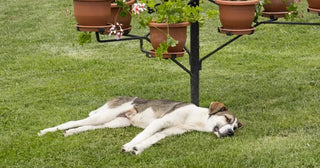For a long time, I didn’t think much about structure in our home. I figured my pets would just go with the flow. But the truth is, they thrive when the day has rhythm—something they can count on, no matter what’s going on around them.
Over the years, I’ve learned that even small, steady habits can improve our pets’ health, mood, and behavior. Whether it's a gentle walk, quiet time before bed, or a fresh bowl of water, these simple touchpoints create comfort and security.
Here’s what a typical day looks like in our house—and why each part matters.
🐾 Morning: Calm Energy and Predictability

I wake up around the same time each day, and so do Daisy, Max, Bella, and Luna. The dogs know that our morning walk comes before breakfast. It’s a short walk—nothing fancy—but it gives them a sense of direction to start the day.
That walk isn’t just about exercise. It’s part of the routine that keeps Max’s anxiety in check. Without it, he’s noticeably unsettled. If your dog struggles with nerves, you might want to read about how I help dogs with anxiety feel safe at home.
After the walk, it’s breakfast time. I feed all the pets at once. Daisy, who has a sensitive stomach, does better when meals are consistent. Since we locked in feeding times, I’ve noticed fewer tummy troubles. That change really began when we built a schedule, and I wrote more about it in this article on dog routines.
For Luna, our cat, breakfast includes a portion of wet food—one of the ways I help her stay hydrated. Cats can be picky about drinking water, so this extra moisture goes a long way. If you’ve had trouble with your cat not drinking, I shared what worked for Luna in this post about cat hydration.
🧡 Midday: Rest and Gentle Movement
Late morning and early afternoon are quiet hours in our home. The dogs nap, the cat finds a sunny spot, and I focus on work. But I always keep a soft eye on them, especially Buddy—our senior dog.
Some days, I notice him shifting uncomfortably in his bed or hesitating before getting up. Arthritis can do that. That’s why midday is when I check his comfort levels—make sure his bedding is warm and supportive, his water is close by, and he’s not overexerting himself.
If you’ve got an older dog showing signs of stiffness or slowing down, you might find comfort in what I wrote about helping my dog with arthritis.
We also take short walks in the afternoon, just to stretch. Nothing long or stressful—just movement to keep joints loose and moods lifted.
🍽️ Afternoon: Enrichment and Engagement
In the late afternoon, the house gets livelier. That’s when I set aside 15–30 minutes for play, training, or puzzle feeders. Mental engagement is just as important as physical movement—especially for Max, who gets overwhelmed if he has too much pent-up energy.
Bella loves a game of fetch, but she’s also perfectly happy chasing a treat-dispensing ball across the rug. Daisy prefers sniff games. And Luna? She comes alive for anything that dangles or rustles.
This kind of enrichment isn't just “fun”—it’s a tool that helps with anxiety, digestion, and sleep. When pets have something to focus on during the day, they tend to be more relaxed at night. That connection between routine and emotional well-being has been a huge shift for us.
💧 Evening: Winding Down and Staying Hydrated

Evening is all about winding down. Before dinner, I refresh everyone’s water bowls—even Luna’s hidden one behind the bookshelf (yes, she insists on privacy).
One thing I’ve kept doing, even now, is using a cat fountain to encourage Luna to drink more. I also occasionally mix in low-sodium broth to keep her water interesting. These habits came out of trial and error.
Dinner happens at the same time each evening. This matters a lot for Daisy’s digestion and Max’s stress. A consistent evening meal helps regulate their moods—something I didn’t realize until I started timing it better.
🛏️ Night: Cues and Comfort
Before bed, I dim the lights, turn on soft instrumental music, and give the dogs a final potty break. These cues tell them it’s time to relax.
Max used to pace at night, unsure when I’d turn in. But once I started using the same bedtime rhythm—music, lights, soft voices—he started sleeping more soundly.
If you’re dealing with a dog who’s restless at night, I wrote more about that in the piece on managing dog anxiety at home.
Buddy gets a gentle massage on his legs before bed. It helps with circulation, especially on colder nights. And I make sure his ramp is secure so he can still get up onto the couch if he wants comfort.
🌙 Final Thoughts: The Power of Consistency
I used to think my pets just needed food, water, and some playtime. But what I’ve learned is that it’s the structure behind those things that really helps them thrive.
Every part of our day—from the morning walk to the bedtime routine—plays a role in their physical and emotional health. For Max, it’s about knowing what comes next. For Buddy, it’s about comfort and pacing. For Luna, hydration is key. And for Daisy, consistent mealtimes keep her belly calm.
If you’re looking to improve your pet’s well-being, take a look at your day. Not to overhaul it—but to gently shape it into something more predictable and peaceful.
Even one small change can help. And over time, those changes build a life your pets can trust.
Let me know what your day looks like with your pets. What small things make a big difference in your home?
